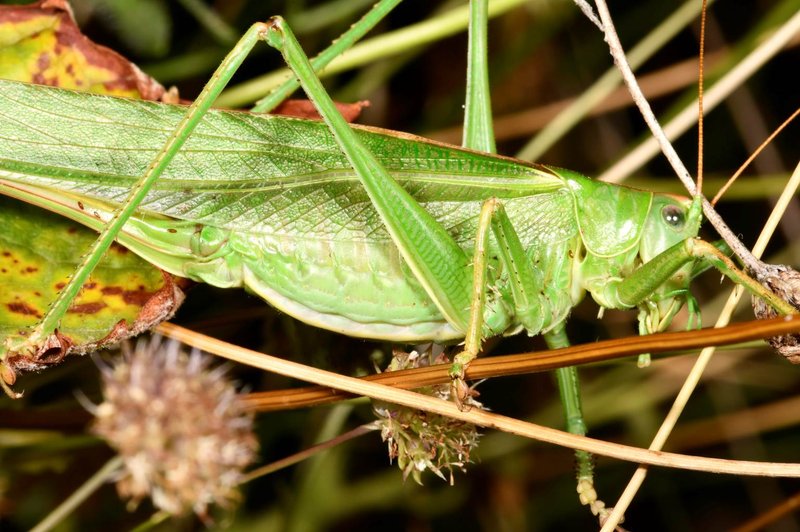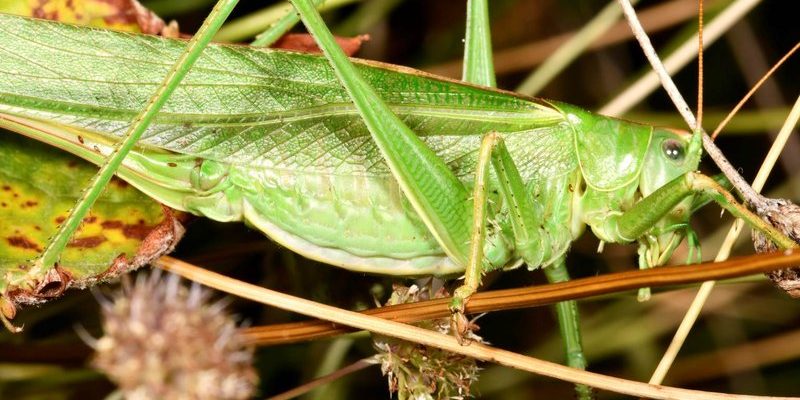
Understanding Bush Crickets
Bush crickets, also known as bush crickets, are fascinating creatures that have a lot more going on than meets the eye. You might be used to seeing regular crickets in your yard, but bush crickets are a bit different. These little insects belong to the family Tettigoniidae, which is a part of the Orthoptera order, the same order that includes grasshoppers and locusts. With over 6,000 species worldwide, they come in various sizes, colors, and patterns. It’s not uncommon to see them blending into the foliage, thanks to their excellent camouflage skills.
What really sets bush crickets apart from their cricket cousins is their striking appearance and unique mating calls. They have long, slender bodies and long antennae, often longer than their bodies, giving them a distinctive look. Their songs—which can vary from rhythmic chirps to complex melodies—are often heard during warm evenings in late summer. These calls are not just for show; they serve a vital purpose in attracting mates and establishing territory. Imagine standing in a forest at dusk, the air filled with the soft, rhythmic serenade of these nocturnal musicians.
When you think about bush crickets, you might wonder where they live and what they eat. Most species prefer bushy, grassy areas where they can hide from predators and find food easily. Their diet mainly consists of leaves, flowers, and seeds, which they consume using their powerful mouthparts. So, let’s dive deeper into the world of bush crickets and explore their incredible characteristics and behaviors.
Physical Characteristics
Bush crickets come in a variety of shapes and sizes, each species unique in its own right. Most bush crickets range from 1 to 10 centimeters long. Their bodies can be slender or more robust, but a common feature is their long, gripping hind legs, which help them leap away from threats. You might notice that some have striking colors or elaborate patterns on their bodies, acting as a disguise against predators. This ability to blend in with their surroundings is often a lifesaver, allowing them to hide in plain sight among leaves and grasses.
One of the most notable features of bush crickets is their long antennae, which can be even longer than their bodies. These antennae are essential for navigating their environment and finding mates. They are sensitive to touch and vibrations, allowing bush crickets to detect even the slightest movements around them. When you spot one of these critters, observe how they whip their antennae back and forth, constantly scanning their surroundings for potential threats or opportunities.
It’s also worth mentioning their wings. While some bush crickets possess wings, others do not. Those with wings can fly short distances when necessary, but most prefer to stay grounded and rely on their powerful legs to jump away from danger. Whether winged or wingless, these insects showcase a range of colors, from greens and browns to dazzling reds and yellows. This variety not only makes them easier to spot in nature but also serves an essential role in their survival strategy.
Habitat and Distribution
Bush crickets can be found in a variety of habitats around the globe, but they tend to thrive in areas rich in vegetation. You might find them in grasslands, forests, and shrublands, where the foliage offers both food and shelter from predators. Their preference for these lush environments means that they are often most active in the summer months, making them a familiar sound in warm evenings. If you happen to walk through a meadow during this time, you might hear their distinctive calls echoing through the air.
These insects are distributed across many continents, with particularly diverse populations found in tropical and temperate regions. In Europe alone, there are about 250 different species! Each species has adapted to its local environment, leading to a splendid variety in behavior and physical characteristics. For example, some bush crickets prefer the cooler, damper settings of woodland areas, while others flourish in hot, sun-drenched grasslands.
Despite their broad distribution, bush crickets face various threats, including habitat loss due to urbanization and agricultural development. As their living spaces shrink, so does their population. Conservation efforts are essential to ensure that these remarkable insects continue to thrive in their natural habitats. By preserving their environment, we not only protect bush crickets but also contribute to the overall health of local ecosystems.
Feeding and Diet
Bush crickets are primarily herbivorous, which means they enjoy a diet rich in plant material. You’ll often find them munching on leaves, flowers, and seeds. They use their strong mouthparts, known as mandibles, to shred and consume their meals. This herbivorous diet plays a vital role in maintaining the ecological balance in their habitats, as they help control vegetation growth and serve as prey for various predators.
Interestingly, some bush crickets are known to be opportunistic feeders. This means that, when the opportunity arises, they might also consume smaller insects. This behavior can be particularly common in species where food is scarce. Imagine a bush cricket carefully scouring its environment, weighing its options between a juicy leaf or a small insect. This adaptability is key for survival, especially in challenging conditions.
In addition to their varied diet, bush crickets have specific feeding habits that can be quite fascinating. They tend to feed more actively during the evening and nighttime hours, which is when they are most active. This nocturnal feeding pattern helps them avoid many daytime predators, allowing them to enjoy their meals in relative safety. If you ever find yourself outdoors at night, keep your eyes peeled for these little critters as they nibble on their favorite snacks under the dim light of the moon.
Reproduction and Life Cycle
The reproductive habits of bush crickets are as intriguing as their physical characteristics. Mating typically occurs during the warm months, with males using their melodic calls to attract females. Each species has its unique song, ranging from soft chirps to more elaborate melodies. Imagine a summer night filled with a symphony of bush cricket calls, each trying to outdo the other in a bid to impress potential mates. This competition is fierce, and only the most appealing songs will gain the attention of females.
Once a female chooses a mate, she will lay her eggs in the ground or within plant tissues, depending on the species. The eggs are often placed in moist environments to ensure they develop properly. After a few weeks, the eggs hatch into nymphs, which resemble tiny versions of adult bush crickets but lack wings. These nymphs will gradually grow and molt several times, shedding their exoskeleton as they develop. This molting process is crucial, allowing them to increase in size and strength.
As bush crickets mature, they will reach adulthood within a few months, ready to join the chorus of nighttime serenades. The lifespan of a bush cricket can vary depending on the species, but many live for about one year. During this time, they focus on reproduction and proving their worth in the great symphony of life—a fitting end for these remarkable insects.
Behavior and Communication
Bush crickets are known for their unique communication methods, primarily through sound. The males produce their characteristic calls as a way to attract females. Each species has its distinct song, which can be quite complex. Think of it like a musical competition where each male tries to outsing the others to win the affection of a mate. These sounds can travel long distances, helping to ensure that their calls are heard by potential partners.
In addition to mating calls, bush crickets use sound for other purposes, such as signaling danger or establishing territory. When threatened, a bush cricket might produce a warning sound to let others know of a nearby predator. This behavior not only helps protect themselves but also aids in the survival of their fellow bush crickets. Imagine a neighborhood watch system, but for insects!
Bush crickets are also quite shy creatures. They prefer to stay hidden in the foliage during the day, using their excellent camouflage to avoid detection. You’ll often find them perched on leaves or blending into the background. When they sense danger, their natural instinct is to stay motionless or leap away, using their powerful hind legs to escape. This combination of vocal communication and stealth makes bush crickets fascinating ambassadors of the insect world.
Interesting Facts about Bush Crickets
| Fact | Description |
|---|---|
| Species Diversity | There are over 6,000 species of bush crickets worldwide. |
| Size Range | Bush crickets typically range from 1 to 10 centimeters in length. |
| Singing Ability | Males produce unique songs that vary between species, primarily to attract females. |
| Diet | They primarily feed on leaves, flowers, and seeds, but may also eat small insects. |
| Habitat | They thrive in densely vegetated areas like grasslands and forests. |
| Lifespan | Most species live for about one year, depending on environmental conditions. |
Conservation Status
While many bush cricket species are widespread and not currently threatened, some populations are declining due to habitat loss and environmental changes. Urbanization, agricultural expansion, and climate change have significantly impacted their natural habitats, making it crucial to focus on conservation efforts. Conservationists play a vital role in studying these insects, advocating for the preservation of their ecosystems, and protecting their habitats.
You might wonder how you can help bush crickets in your area. One simple way is to create a welcoming environment in your backyard or garden. Planting native vegetation and avoiding pesticides can go a long way in providing a safe haven for these little musicians. By fostering a healthy environment, you contribute to the well-being of not just bush crickets but the entire ecosystem.
Moreover, education and awareness are key to preserving these incredible insects. By sharing information about bush crickets with friends and family, you help spread the word about their importance in our world. Every small effort counts, and together, we can ensure that these remarkable creatures continue to sing their songs for generations to come.
FAQ
What do bush crickets look like?
Bush crickets are characterized by their long, slender bodies and long antennae. They can range in color from green and brown to vibrant reds and yellows. Their bodies can be about 1 to 10 centimeters long, and their long hind legs are ideal for jumping away from predators.
Where do bush crickets live?
Bush crickets can be found in various habitats, including grasslands, forests, and shrublands. They thrive in densely vegetated areas, where they can easily find food and shelter.
How do bush crickets communicate?
Bush crickets primarily communicate through sound. Males produce distinct songs to attract females, which can vary between species. They may also use sound to signal danger and establish territory within their environment.
What do bush crickets eat?
Bush crickets are mostly herbivorous, feeding on leaves, flowers, and seeds. Some species may also consume smaller insects when necessary, especially in times of food scarcity.
How long do bush crickets live?
The lifespan of a bush cricket typically ranges from a few months to about one year. Their life cycle involves several molts as they grow from nymphs into adult insects.
Are bush crickets endangered?
While many bush cricket species are not currently threatened, some populations are declining due to habitat loss and environmental changes. Conservation efforts are crucial to protect these creatures and their habitats.
How can I help bush crickets in my area?
You can help bush crickets by creating a welcoming environment in your garden. Plant native vegetation, avoid using pesticides, and educate others about the importance of these insects to foster awareness and conservation efforts.

